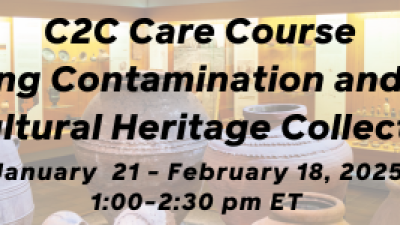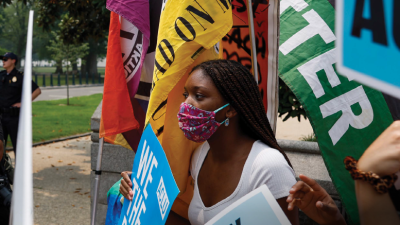
This visual Data Story is based on findings from the 2024 Annual Survey of Museum-Goers, a national survey of American museum visitors from AAM and Wilkening Consulting. Every year, the survey partners with individual museums to research their audiences and yield insights about their behaviors and preferences, both on an institutional and national level. Interested in joining the 2025 edition on the themes of repeat visitation, social connection, and community trust and responsibility? Sign up by February 28, 2025, for a special early bird rate.


Skip over related stories to continue reading article“Bombarded”
“Exhausted”
“Frustrated”
Over the past several years, we have noticed that respondents to the Annual Survey of Museum-Goers are increasingly sharing negative feelings. Sometimes these negative feelings are in response to content they disagree with.
But much of this increased negativity is a response to perceived changes in their daily lives, including:
- The constant “bombardment” of the political and news cycle
- Eco-anxiety or despair over climate change
- Struggles with work and family obligations
- Financial challenges
- Increased political polarization
This negativity seems to be an expression of what many researchers have identified as a growing crisis in mental health.
In the 2022 Annual Survey of Museum-Goers, most people expressed that museums support their wellbeing.(1) In the 2024 survey, however, we specifically considered the importance of hope in motivating museum-goers to take a more positive and proactive approach to the future.
To find out what the public thinks about museums and hope, we asked a series of five questions.
Three “indirect” questions:
What makes these “indirect” questions? To the respondent, they don’t read as questions about hope, but other things. That’s important because it means that people who don’t feel that strongly about the cultivation of hope in museums tend to skip over the “hope” answers, instead choosing other answers that are more important to them … and they can do so without feeling judged about their answers.
1. What are the most important ways that museums should share and engage you with their content?
Out of the nine potential answers we provided, we are interested in this one:
Promoting hope by helping me imagine a better future
Frequent Museum-Goers: 16%
U.S. Adults: 19%
2. When you think of an ideal museum visit, what do you want to experience?
Out of eight potential answers we provided, we are interested in this one:
Feeling greater hope by helping me imagine a better future
Frequent Museum-Goers: 14%
U.S. Adults: 17%
3. Thinking about how imagination can support learning in museums, which of the following outcomes would you like visitors to experience?
Out of the seven potential answers we provided, we are interested in this one:
Helping visitors imagine a better future, giving us something positive to work towards
Frequent Museum-Goers: 49%
U.S. Adults: 48%
See anything interesting here?
We did!
Respondents were far less enthusiastic when we explicitly included the word “hope,” and more enthusiastic when we dropped the word.
Which means that those who did choose hopeful answers, well, we can feel pretty confident that they support this work in museums.
A “direct,” non-museum question
This question was intended to ask directly about hope … but not in a museum context. We wanted more general thoughts about hope, from their everyday lives.
- Feeling a greater connection to humanity
- Frequent Museum-Goers: 41%
- U.S. Adults: 34%
- Art – seeing beauty in the things humans have created
- Frequent Museum-Goers: 68%
- U.S. Adults: 40%
- Nature – seeing beauty or wonder in animals, plants, environments, etc.
- Frequent Museum-Goers: 78%
- U.S. Adults: 59%
- History – understanding how people in the past faced challenges and overcame them
- Frequent Museum-Goers: 60%
- U.S. Adults: 46%
- Seeing people helping others
- Frequent Museum-Goers: 62%
- U.S. Adults: 54%
- Finding respite and escape, allowing me to recharge
- Frequent Museum-Goers: 48%
- U.S. Adults: 39%
- Feeling there are things I can do to address challenges or problems
- Frequent Museum-Goers: 43%
- U.S. Adults: 34%
- Being part of a community of people working to make things better
- Frequent Museum-Goers: 54%
- U.S. Adults: 36%
- My religion or faith
- Frequent Museum-Goers: 32%
- U.S. Adults: 37%
- None of these
- Frequent Museum-Goers: 1%
- U.S. Adults: 4%
Good news! Virtually everyone said they could find hope in something, and many of the answers we provided are rather museum-y, focusing on the things museums often share.
A “direct” museum question
Finally, we wanted to know what they think about hope in a museum setting, asking respondents “how important it is to you that museums work to cultivate hope among visitors?”
- Very important
- Frequent Museum-Goers: 37%
- U.S. Adults: 43%
- Somewhat important
- Frequent Museum-Goers: 43%
- U.S. Adults: 43%
- Not very important
- Frequent Museum-Goers: 13%
- U.S. Adults: 9%
- Not at all important
- Frequent Museum-Goers: 5%
- U.S. Adults: 8%
Overall, there is good news here as well, as at least four out five respondents gave positive answers.
Feeling lost in the numbers? We were too! To help, we sorted respondents into three segments, based on the patterns of their individual responses to all five questions.
- Resistant: answered negatively to all museum-related hope questions.
- Frequent Museum-Goers: 18%
- U.S. Adults: 13 %
- Ambivalent: these respondents like the idea of hope being cultivated in museums, but are not necessarily seeking it out. They typically gave lukewarm responses to hope questions, or gave conflicting pro/against responses.
- Frequent Museum-Goers: 43%
- U.S. Adults: 42%
- Enthusiastic: these respondents loved the idea of hope being cultivated in museums, and chose positive answers to all hope questions.
- Frequent Museum-Goers: 40%
- U.S. Adults: 45%
While about equal numbers are enthusiastic or more ambivalent about the cultivation of hope in museums, there is a minority opinion that pushed back, responding negatively.
In the next Data Story in this series, we’ll explore these different perspectives in more detail, including the somewhat surprising finding that some people view cultivating hope for a better future to be too political for museums.
Stay tuned.
Annual Survey of Museum-Goers Data Stories are created by Wilkening Consulting on behalf of the American Alliance of Museums. Sources include:
• 2024 Annual Survey of Museum-Goers, n = 90,178; 202 museums participating
• 2024 Broader Population Sampling, n = 2,154
• 2017 – 2023 Annual Surveys of Museum-Goers
(1) For two Data Stories on wellbeing, go to: https://wilkeningconsulting.com/?s=wellbeing&post_types=post.
*Data Stories share research about both frequent museum-goers (typically visit multiple museums each year) and the broader population (including casual, sporadic, and non-visitors to museums).
More Data Stories can be found at wilkeningconsulting.com/data-stories.









Comments